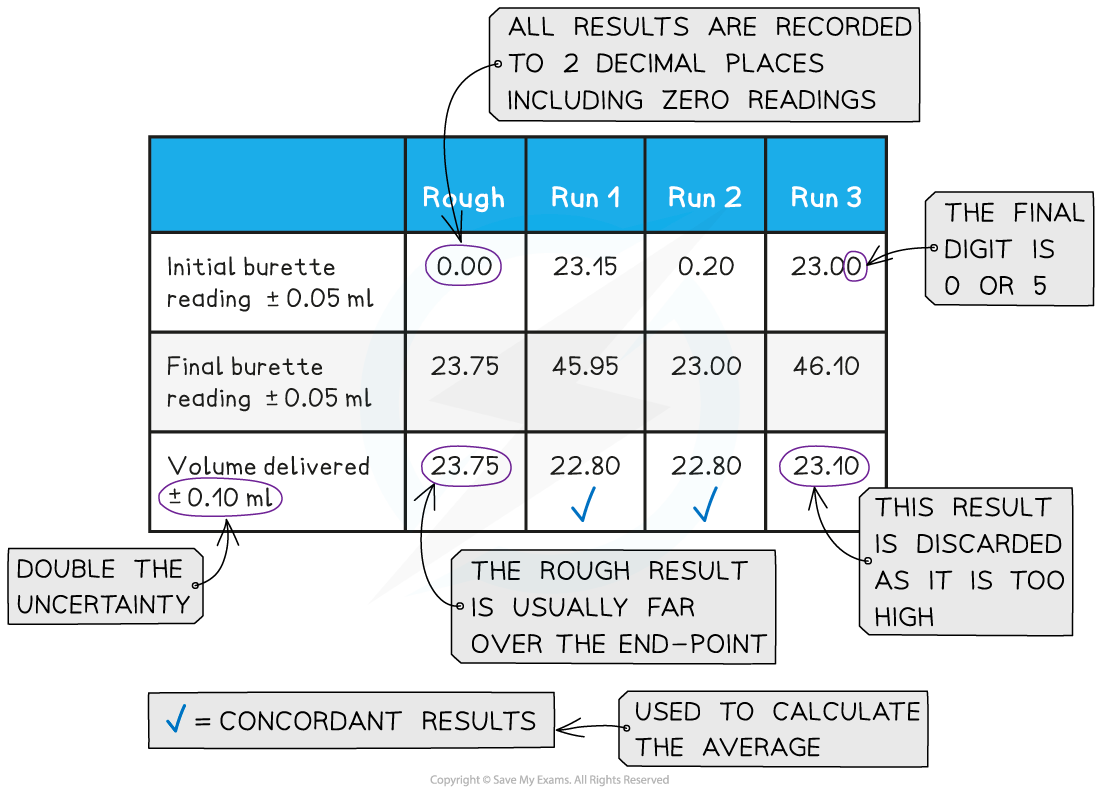Acid-base Titrations
Volumetric Analysis
- Volumetric analysis is a process that uses the volume and concentration of one chemical reactant (standard solution) to determine the concentration of another unknown solution
- The technique most commonly used is a titration
- The volumes are measured using two precise pieces of equipment, a volumetric or graduated pipette and a burette
- Before the titration can be done, the standard solution must be prepared
- Specific apparatus must be used both when preparing the standard solution and when completing the titration, to ensure that volumes are measured precisely

Some key pieces of apparatus used to prepare a volumetric solution and perform a simple titration
- Beaker
- Burette
- Volumetric Pipette
- Conical Flask
- Volumetric Flask
Making a Standard Solution
- Chemists routinely prepare solutions needed for analysis, whose concentrations are known precisely
- These solutions are termed volumetric solutions or standard solutions
- They are made as accurately and precisely as possible using three decimal place balances and volumetric flasks to reduce the impact of measurement uncertainties
- The steps are:


Volumes & concentrations of solutions
- The concentration of a solution is the amount of solute dissolved in a solvent to make 1 dm3 of solution
- The solute is the substance that dissolves in a solvent to form a solution
- The solvent is often water
- A concentrated solution is a solution that has a high concentration of solute
- A dilute solution is a solution with a low concentration of solute
- Concentration is usually expressed in one of three ways:
- moles per unit volume
- mass per unit volume
- parts per million
Performing the Titration
- The key piece of equipment used in the titration is the burette
- Burettes are usually marked to a precision of 0.10 cm3
- Since they are analogue instruments, the uncertainty is recorded to half the smallest marking, in other words to ±0.05 cm3
- The end point or equivalence point occurs when the two solutions have reacted completely and is shown with the use of an indicator

The steps in a titration
- A white tile is placed under the conical flask while the titration is performed, to make it easier to see the colour change

- The steps in a titration are:
- Measuring a known volume (usually 20 or 25 cm3) of one of the solutions with a volumetric pipette and placing it into a conical flask
- The other solution is placed in the burette
- To start with, the burette will usually be filled to 0.00 cm3
- A few drops of the indicator are added to the solution in the conical flask
- The tap on the burette is carefully opened and the solution added, portion by portion, to the conical flask until the indicator starts to change colour
- As you start getting near to the end point, the flow of the burette should be slowed right down so that the solution is added dropwise
- You should be able to close the tap on the burette after one drop has caused the colour change
- Multiple runs are carried out until concordant results are obtained
- Concordant results are within 0.1 cm3 of each other
Recording and processing titration results
- Both the initial and final burette readings should be recorded and shown to a precision of ±0.05 cm3, the same as the uncertainty

A typical layout and set of titration results
- The volume delivered (titre) is calculated and recorded to an uncertainty of ±0.10 cm3
- The uncertainty is doubled, because two burette readings are made to obtain the titre (V final – V initial), following the rules for propagation of uncertainties
- Concordant results are then averaged, and non-concordant results are discarded
- The appropriate calculations are then done
Percentage Uncertainties
- Percentage uncertainties are a way to compare the significance of an absolute uncertainty on a measurement
- This is not to be confused with percentage error, which is a comparison of a result to a literature value
- The formula for calculating percentage uncertainty is as follows:

Adding or subtracting measurements
- When you are adding or subtracting two measurements then you add together the absolute measurement uncertainties
- For example,
- Using a balance to measure the initial and final mass of a container
- Using a thermometer for the measurement of the temperature at the start and the end
- Using a burette to find the initial reading and final reading
- In all these example you have to read the instrument twice to obtain the quantity
- If each you time you read the instrument the measurement is ‘out’ by the stated uncertainty, then your final quantity is potentially ‘out’ by twice the uncertainty



